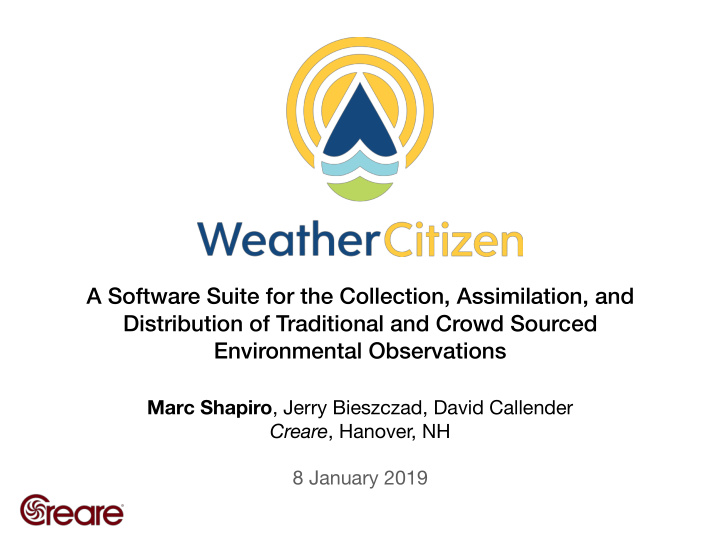



A Software Suite for the Collection, Assimilation, and Distribution of Traditional and Crowd Sourced Environmental Observations Marc Shapiro , Jerry Bieszczad, David Callender Creare , Hanover, NH 8 January 2019
Motivation Marine weather "nowcasts" and forecasts are critical to • maintain situational awareness and ensure safe navigation Existing marine weather observations are sparse • Buoy Map from NOAA NDBC Example Map from VOS Observations
Smartphones for Crowd Sourcing • Smartphones support multi-modal environmental sensing Observations : UI, Camera, Microphone - Sensors: Pressure, Temperature, Light, ... - Location : GPS, Network - • Project Goals : Enable crowd-sourced weather observations - Disseminate observations in real time - Promote data access and control - Advance development of data products and insights using crowd-sourced data
Crowd Sourcing Challenges Quality control and data validation Data aggregation Data access, control, infrastructure privacy, interoperability Data wrangling and Incentivizing data harmonization collection Products Curating Inputs
Modular full-stack platform to support weather-related crowd-sourcing REST Server with OpenAPI for Geospatial Database Data Access Cross Platform Mobile Application for Data Collection Data Processing Libraries Webmap Visualization (MATLAB, Python)
WeatherCitizen App Collect Input Observations Record device sensors • Input image , audio , or data • Record device sensors down • Customize input fields to to 100 ms frequency • Connect to external BLE support additional observations sensors (i.e. Kestrel)
WeatherCitizen Server • Portable HTTP based server architecture • REST API (OpenAPI) for data upload/download (Python Eve) • GeoJSON formatted database (MongoDB)
WeatherCitizen Tools • LeafletJS webmap visualization to explore datasets • View or Download historical data as geojson, csv
WeatherCitizen Tools • Python module to facilitate access and manipulation of data • In Progress: Integration with PODPAC geospatial analysis library Pipeline for Observational Data Processing, Analysis, and Collaboration
Additional Capabilities • Export app data directly to .json / .csv (skip server) • Push manual inputs to Twitter with specific hashtag • In Progress: View nearby public observations in app
Example: Marine Weather Research vessel collecting daily sea state statistics
Example: Marine Weather Image log of research cruise in Pacific Northwest
Example: Marine Weather Oyster farmer tracking the salinity of oyster bed
Workflows • Manual Observations - Hourly / Daily observations - Image, audio, custom input observation - App provides notification reminders • Automatic Device Recording - "Weather Station" mode records sensor values every ~1 minute - Each data point includes burst of sensor values over 5 seconds
Processing and Filtering • Data records stored as raw GeoJSON Interoperable with most GIS platforms - • Sensor "bursts" stored in compressed Protobuf format • Server supports geospatial queries through API • Python server and tools support hooks and filter functions Enables dynamic validation of data - • Example Hooks - Include nearest OpenWeather forecast for data record - Include USGS Elevation for device location - Include the nearest crowd-sourced data point
Insights from WeatherCitizen Data Measure wave period and frequency using orientation sensor Measure wind speed using Label uploaded images with only device pressure sensor custom machine learning model
Coming Soon... • Data assimilation experiment using WeatherCitizen data • Serverless database architecture to enable self-hosting • User profiles and granular privacy settings • Image recognition model for weather-related phenomena • Looking for early adopters to provide feedback and drive future use-cases
Acknowledgements This work is supported by: • NOAA SBIR Contract No. WC133R17CN0081 • US Army SBIR Contract No. W91E518C0001 Any opinions, findings and conclusions or recommendations expressed in this material are those of the author(s) and do not necessarily reflect the views of the U.S. Army Corps of Engineers or NOAA.
Ways to Connect At AMS: • Poster Session Today - 4:00 PM-6:00 PM in Hall 4, Poster #671 " PODPAC: A Python Library for Automatic Geospatial Data Harmonization and Seamless Transition to Cloud-Based Processing " Email : • Marc Shapiro: mls@creare.com • Request Software: weathercitizen@creare.com Online : • Project Website: https://weathercitizen.org • Creare: http://creare.com
Recommend
More recommend